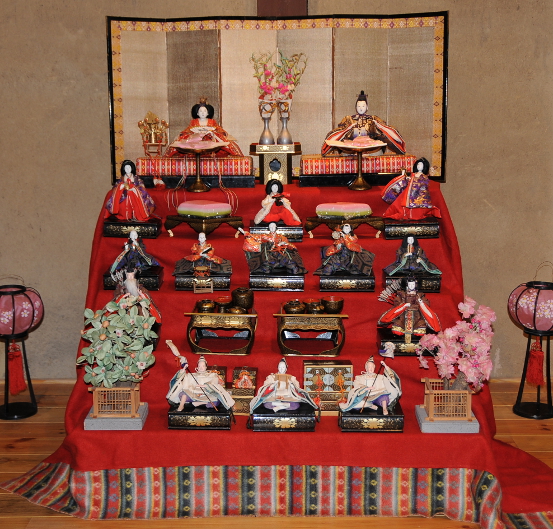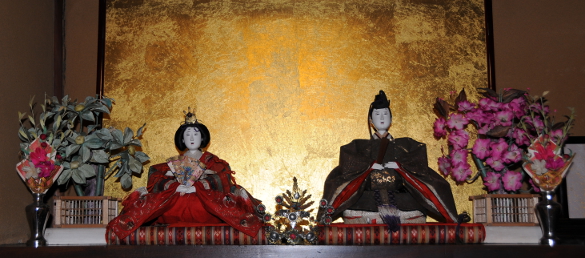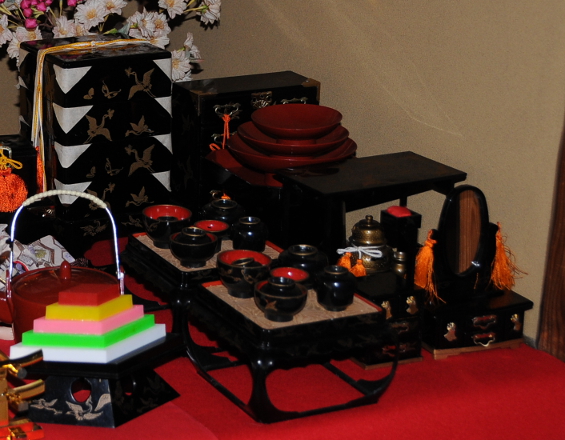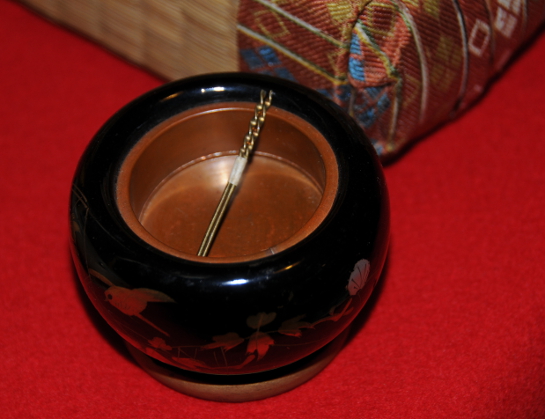March 3rd marks the day of hina matsuri, the doll festival. Since this time is more or less the beginning of spring, it is also called momo-no-sekku or peach festival, or, since this day is meant to celebrate the girls of a family, it is simply called girl’s day or festival. In the weeks leading up to March 3rd, elaborate displays of dolls are prepared, but since many families have inherited those dolls, the girls are not meant to play with them anymore.
 The above is a typical traditional hinadan with five layers containing dolls and other accessories. They are made to resemble court nobles and retainers of the Heian era, when Kyoto first became the capital of Japan, some 1000 years ago. On top you see the two main dolls, the dairi-bina. One step below there are three ladies in waiting, usually holding cups and accessories for drinking sake. The center of the display above shows five court musicians with drums and flutes. Below them are the minister of the left – the one with the beard, since this is the higher rank and thus the person must be older – and the minister of the right. (Here, those dolls should be switched since the “left” refers to the viewpoint of the dairi-bina). Finally, at the lowest layer, there are three footmen or samurai, the lowest retainers of the court, and these are called the whiny, the angry and the merry drinker, interestingly.
The above is a typical traditional hinadan with five layers containing dolls and other accessories. They are made to resemble court nobles and retainers of the Heian era, when Kyoto first became the capital of Japan, some 1000 years ago. On top you see the two main dolls, the dairi-bina. One step below there are three ladies in waiting, usually holding cups and accessories for drinking sake. The center of the display above shows five court musicians with drums and flutes. Below them are the minister of the left – the one with the beard, since this is the higher rank and thus the person must be older – and the minister of the right. (Here, those dolls should be switched since the “left” refers to the viewpoint of the dairi-bina). Finally, at the lowest layer, there are three footmen or samurai, the lowest retainers of the court, and these are called the whiny, the angry and the merry drinker, interestingly.
Between the ladies in waiting, you can see two plates with colorful cakes; these are mochi and meant as an offering to the gods. Of course, the hina matsuri has its roots in religion, in this case in the ancient belief that the illnesses, bad luck, and general impurities of their owners would be transferred to the dolls when touching them. Very simple dolls made from straw were displayed throughout the year on the household altar in the kitchen, and on March 3rd, they would be thrown into a river or directly into the ocean in order to take away all the negativity of the past year. This practice still survives in the rituals of some shrines, where you write your wishes on a piece of paper shaped like a doll, and then throw it into the shrine’s stream.
 Nowadays, the dolls are not thrown away any longer but carefully packed away during the year, a bit like Western Christmas decorations. This practice goes back to the first shoguns of the Edo period, when the dolls were given as presents to daughters of the nobility. Once the merchant class became rich as well in the late Edo period and Meiji era, the dolls became more and more elaborate and expensive and hina matsuri spread throughout Japan. Today, new sets of dolls in traditional styles can be very expensive, I have seen some dairi-bina costing a million yen and more.
Nowadays, the dolls are not thrown away any longer but carefully packed away during the year, a bit like Western Christmas decorations. This practice goes back to the first shoguns of the Edo period, when the dolls were given as presents to daughters of the nobility. Once the merchant class became rich as well in the late Edo period and Meiji era, the dolls became more and more elaborate and expensive and hina matsuri spread throughout Japan. Today, new sets of dolls in traditional styles can be very expensive, I have seen some dairi-bina costing a million yen and more.
 The reason for this is that all dolls are very elaborately dressed in fine silk garments, but the biggest amount of work goes into the dairi-bina. They are the centre piece of the display and the most important, or in some cases, the only part. On the right side sits the male obina, and on the left side there is the female mebina. They are dressed in Heian-style clothes, which means that the mebina wears a junihitoe, twelve layers of kimono, an elaborate Chinese crown, and a tiny folding fan, whereas the obina wears a traditional headdress, a sceptre, and a large ceremonial sword. The couple above sits in front of a screen made with real gold leaf, just like the emperor and empress would, but the Japanese usually do not refer to the dairi-bina as such. They prefer calling them taishi-sama – imperial prince – and hime-sama – lady; when you remember that the emperor was a god until the last century it should be clear why.
The reason for this is that all dolls are very elaborately dressed in fine silk garments, but the biggest amount of work goes into the dairi-bina. They are the centre piece of the display and the most important, or in some cases, the only part. On the right side sits the male obina, and on the left side there is the female mebina. They are dressed in Heian-style clothes, which means that the mebina wears a junihitoe, twelve layers of kimono, an elaborate Chinese crown, and a tiny folding fan, whereas the obina wears a traditional headdress, a sceptre, and a large ceremonial sword. The couple above sits in front of a screen made with real gold leaf, just like the emperor and empress would, but the Japanese usually do not refer to the dairi-bina as such. They prefer calling them taishi-sama – imperial prince – and hime-sama – lady; when you remember that the emperor was a god until the last century it should be clear why.
 The dolls are accompanied with all sorts of accessories in miniature. While the dolls are usually bought together in a set, or at least per layer, the other accessories can be bought at any time. This explains the difference in size that is often seen in the diplays. The above picture shows parts of a girl’s dowry: A mirror stand, a cabinet with utensils for tea ceremony, a sewing box, and a tansu – a chest of drawers for kimono – at the back. These are the standard items a girl would get from her parents upon her wedding, and with these things she would enter the house of her husband. Below you can see some more household necessities: a palanquin and an oxcart, but especially the latter was for the use of nobility only.
The dolls are accompanied with all sorts of accessories in miniature. While the dolls are usually bought together in a set, or at least per layer, the other accessories can be bought at any time. This explains the difference in size that is often seen in the diplays. The above picture shows parts of a girl’s dowry: A mirror stand, a cabinet with utensils for tea ceremony, a sewing box, and a tansu – a chest of drawers for kimono – at the back. These are the standard items a girl would get from her parents upon her wedding, and with these things she would enter the house of her husband. Below you can see some more household necessities: a palanquin and an oxcart, but especially the latter was for the use of nobility only.
 Also other practical things can be included in the display, for example lots of dishes, trays, sets of bowls etc. You can see the go-boards above, and below is a tiny hibachi, an oldfashioned heater where charcoal would be burned, not more than 5 cm in diameter. What is interesting about these items is that for the most expensive displays they were made from the same materials and were just as meticulously produced and as elaborately decorated as the real sized originals.
Also other practical things can be included in the display, for example lots of dishes, trays, sets of bowls etc. You can see the go-boards above, and below is a tiny hibachi, an oldfashioned heater where charcoal would be burned, not more than 5 cm in diameter. What is interesting about these items is that for the most expensive displays they were made from the same materials and were just as meticulously produced and as elaborately decorated as the real sized originals.
 All in all the displays are beautiful, and even as an adult I need quite some time to take it all in. I can only imagine what a small girl would have to say to these dolls. Well, as I said, probably the same as one of our girls in front of a Christmas tree…
All in all the displays are beautiful, and even as an adult I need quite some time to take it all in. I can only imagine what a small girl would have to say to these dolls. Well, as I said, probably the same as one of our girls in front of a Christmas tree…
